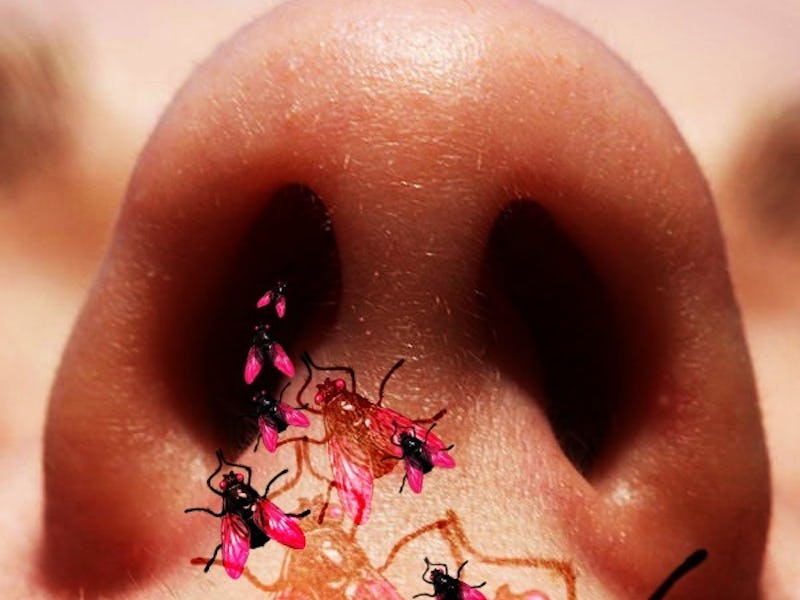What Actually Happens When a Bug Flies Up Your Nose
No, it doesn't end up in your brain.

The sheer surprise of finally hitting a ball at home plate made me inhale sharply — so sharply that I sucked a bug in through my nose. I felt it lodge in the ether between my ear and my brain, where I immediately imagined it paddling through my snot. I was paralyzed: Should I blast it out, as if it were a mere stuffed nose? Or should I snort inward, like it was some badly cut drug?
As I envisioned it tunneling deeper into my head on that hot summer night, I realized how little I understood how my own nose worked.
Fortunately, Dr. Richard A Lebowitz, a New York University Langone Medical Center rhinologist who makes his living exploring nasal cavities, was able to assuage my major fear — that the fly would enter my brain, lay eggs, or eat my gray matter. “Most anything that goes in the nose should end up in the stomach,” he said in a phone call with Inverse, a day after my intimate sniff. “The bug’s probably swimming around in your stomach now, and not in your nose.” This did not offer as much relief as I might have hoped, but it was a start.
As Dr. Jennifer Villwock, a University of Kansas Medical Center assistant professor of otolaryngology, explained further in an e-mail to Inverse, there are a few paths that a bug that enters a nose can take. It might get caught in the fine nose hairs (vibrissae), which usually act as the nostril’s first line of defense against dust or particulates. “It may then basically turn into a booger and come out or get picked out later!” she says.
Who can say where the nose goes?
There were no insect parts in the snot that came out in my Kleenex, so I was forced to assume the bug had traveled further inward. If that’s the case, Willvock explains, the bug probably ended up in the nasal mucosa, a smooth, pink, hairless region past the vibrissae that is more sensitive to pain. She assured me that it’s rare for a bug to “actually cut the inside of the nose” but pointed out that things that wind up there usually get sneezed out, after being recognized by the body as an irritant.
But I had been trying to sneeze the bug out for many frantic hours, to no avail. At this point, my biggest fear was that the bug was dead and stuck, a carcass studding my nasal lining for the rest of my life. Villwock reassured me that, even if the bug remained trapped in the nose, it would eventually get coated in mucus and then either come out the front with nose blowing or go down the back of the throat.” The mucus-producing cells of the mucosa produce about 1 to 1.5 liters of mucus per day (enough to fill a magnum of wine), she explains, and since we are constantly swallowing throughout the day, most of that mucus winds up in our stomach, together with the nasal debris it washes away.
It occurred to me that I could “hock a loogie” — draw out mucus into my mouth by closing my mouth and inhaling sharply — the same way cocaine users sometimes swallow post-nasal drip. Lebowitz said that this would probably work but didn’t recommend it. “It’s a somewhat disgusting way to do it, but people do it all the time,” he says. “Better to just let it clear naturally and swallow it.”
On rare occasions, both Villwock and Lebowitz admitted, the bug can wind up in the lungs. “That’s the other passageway,” Lebowitz says, explaining that the nose and airway meet in the back of the throat. “Your body’s made to keep things from going down the wrong pipe, but occasionally that could happen.” Villwock agrees this is “rare,” because cartilaginous structures like the epiglottis flop over the vocal cords in order to prevent objects from the nose or mouth from falling inside. If the bug had gotten inside, it would have been pretty obvious: “Think anytime you’ve accidentally inhaled an itty bitty bit of saliva,” she says, describing the embarrassed, red face and the bulging eyes of a person who allows even the tiniest object enter their sensitive airways. “That’s your body’s defense mechanism to protect the lungs and lower airway from these accidental inhalations.”
Two days after the incident, I had not picked out a “boogerified” bug, it did not appear in any of my discarded tissues, and I hadn’t experienced any frantic coughing sessions. And, unless I had a rare defect in my skull base — the bone separating the nasal cavity, sinuses, and the brain — it’s impossible that the bug could have crawled into my gray matter or eyeballs, Villwock said. The rhinologists had to be right: By now, the bug had probably drowned and made its way through my digestive system like all the other protein I normally consume.
But that didn’t change the experience of having been violated by six brittle legs and a chitinous body. I don’t think anything will.
Objects, both living and dead, routinely pass through the nose, but the feeling is rarely transient. “There’s mental anguish,” says Lebowitz. “You get very distressed — the thought of that thing in there. But it’s nothing to be concerned about.”
Days later, I admit to him that I still sometimes imagine the tickle of legs between my ears.
“People have visions of this thing flying up into their brain and what not,” he says. “It’s not gonna happen.”